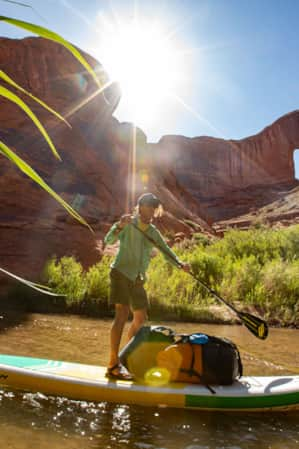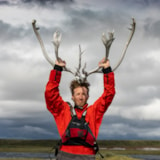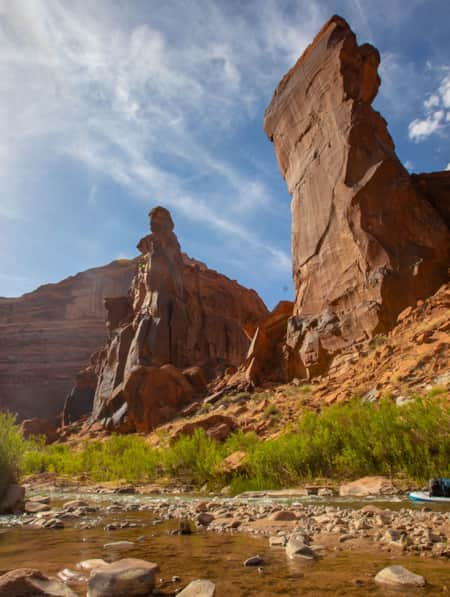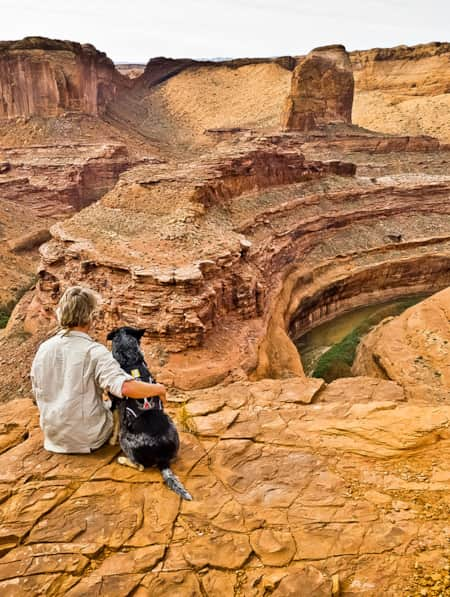Paddling the Escalante River: Surfing Spring’s Runoff Through the Grand Staircase
Four friends embark on an otherworldly standup paddle journey through the heart of the Grand Staircase-Escalante National Monument, assisted by a local guide and his team of llamas.

The weight is bearing down on my back. The wind is blowing stinging sand across my chest, legs and feet. All this monotony is broken up only by the occasional lizard or a blooming desert wildflower.
Trudging across a sand dune with a 10-foot inflatable paddleboard and 70-pound pack seems foreign in this place. I pass a hiker and can feel their bewilderment. Off in the distance I see car windshields glistening with the reflection of the sun. It's far away. The only thing keeping me going, unexpectedly, is the wind blowing through the cylinder of my collapsible paddle, which mimics the sound of a Native American flute.
Back to the Beginning
This trip on the Escalante River had been a bucket list item for me for a decade. I had walked, crossed and gazed upon the river from many different vantages. For this trip, we planned to paddle through the heart of it.
The planning of a paddle trip down a shallow and narrow riverbed like the Escalante can be both a puzzle and a headache. It’s not an undertaking that can be done at any time. Too much or too little water can make the river unrunnable. The river’s flow, based mostly on spring runoff from the mountainous regions of the area, is the key to a successful trip.
Having spent nearly every spring of my adult life in this area, I closely monitored the runoff. Once the sun melts the snow, a short two-to-six week paddling window may present itself. It’s the uncertainty that makes this a difficult, yet satisfying, journey to plan.
I opted to organize a tried-and-true team with a track record of pulling off adventures like this. Just after twilight under a crescent moon in May, I was met by fellow adventurers, Jay Sanavage, Martin Cavada and Rusty Reams on a sandy plain outside Escalante. Also camping with us was my good friend and llama-packing operator, BJ Orozco of Llama2Boot. While we could have put in at the Highway 12 bridge, we opted for a more unique send off.
To truly feel the vibe of the desert, we decided to walk cross-country to an untraditional put-in a couple hours downstream. As morning broke, we compiled our gear, loaded the llamas and set out across the sand with the aid of BJ and his furry, stinky crew. The sand changed to slick rock as Roy, Knick, Jeb and Juan’s leathery feet gingerly clung to the steep trail. Their occasional hum, groan and spitting sounds echoed through the open spaces.
"This trip on the Escalante River had been a bucket list item for me for a decade. I had walked, crossed and gazed upon the river from many different vantages. For this trip, we planned to paddle through the heart of it. "

Based in Boulder, Llama2Boot offers full service pack trips with llamas, drop camps and day hikes around Escalante.

Llamas Roy, Knick, Jeb and Juan navigate the steep trail to the river.
The Put-In
After a couple hours wandering the arid wilderness, we were met with an unusually strange feeling as the river emerged. Water seemed out of place in this unforgiving landscape. The overwhelming dryness was replaced by a cooler riparian atmosphere, while the sun beat down on us as we inflated our paddleboards. We said goodbye to BJ and the llamas — they headed back to their homebase in Boulder — and we set out on a journey down the Escalante with a collection of United States Geological Survey maps.
The serpentine canyons of the Escalante River are some of the most beautiful playgrounds on the planet. From the moment we stood atop our boards, we were transported into a journey of our dreams. Giving ourselves seven days, we hoped to have ample time for side trips.
Thirty minutes into our journey, we made a stop to explore an unnamed section of narrows before remounting our boards and getting back to bumping and cruising through endless bends in the river. At times, we greased our selected lines. During others, we dry-docked on boulders and sandbanks. The river was just deep enough to give us the perfect start.
River Life
Our days were filled with playful sections of paddling and quieter moments of zen. As the miles piled up, so did our drop in elevation. This drop led to faster water and technical paddling. Each moment was stacked with twists and turns, shadow and light. One minute we would flash by a section of rapids, while the next, any one of us could be swallowed whole by the willows lining the shores. In between, we hit slow sections allowing us to take in the surrounding scenery. Rocky, technical switchbacks proceeded to deadfall damming our passageway. We took turns leading to give each member a taste of first tracks.
Running Rapids and Wipeouts
It’s hard to explain how quickly a moment on the Escalante River can change from peaceful bliss to shock. We each had our share of wipeouts. My first was an attempt to nonchalantly manage a fallen cottonwood. With one branch blocking my passage, I lost the battle. My board got hung up and then, as the bow submerged, I was pushed chest deep into the chocolatey runoff.
Running rapids and technical sections were the true highlights of the trip. Our front-loaded Naish Nalu 10’6” inflatables were stable but split decisions were the key to success. A late decision caused either a logjam of boards or a swim.
First person down had the advantage of setting the line but the other three of us had the advantage of witnessing how the line panned out. If a paddler flashed their line, we all attempted to follow. If he failed, we looked for another line. It was a joy to witness our partners either send it or crash into the water.

The red hues of the canyon deepened along with occasional black streaks, making the rock look like it had been etched by the claws of a cougar.
Photo: Ryan Salm
"The serpentine canyons of the Escalante River are some of the most beautiful playgrounds on the planet. From the moment we stood atop our boards, we were transported into a journey of our dreams."

Sleeping Under the Stars
Evening campsites were the much-needed antidote to long days baking under the hot desert sun. Dry flaking skin and sore muscles were intermingled with a multitude of scratches. Our skin needed time out of the water for healing.
Kicking back in a dark semicircle of silhouetted red rock walls proved to be the perfect frame to a firefly-lit sky. Though the river’s echo off the rock walls threw off my perception of space, the sounds also helped settle the built-up adrenaline of the day.
The canyon at night was alive with sights and sounds: the fluttering of a moth or a rustling in the bushes. Nighttime provided the perfect canvas to both recount stories from the day or simply drift into the enigma that is the American Southwest.
Exploring Desert Scenes
Hours of paddling were in contrast to hours of walking through side canyons. The Grand Staircase is its own natural history museum, chock full of alcoves, cathedrals and collections of petroglyphs and pictographs. Although we took our fair share of rest stops, we found ourselves multi-sporting even during our lunch breaks. With so many side canyons and hidden gems to explore, we took advantage of our time. (Read more on how to travel more thoughtfully and help shape a Utah that lasts forever.)

The canyon at night was alive with sights and sounds: the fluttering of a moth or a rustling in the bushes.
Photo: Ryan Salm
"The Grand Staircase is its own natural history museum, chock full of alcoves, cathedrals and collections of petroglyphs and pictographs."

Running rapids and technical sections were the true highlights of the trip.

The river’s flow, based mostly on spring runoff from the mountainous regions of the area, is the key to a successful trip.

Days on the river are filled with playful sections of paddling and quieter moments of zen.
River Lifestyle
The canyon began to change as we passed the 25-mile mark and into Scorpion Gulch. Rock walls grew taller. The red hues deepened along with occasional black streaks, making the rock look like it had been etched by the claws of a cougar. The bends widened, while the river was still stacked with Class I and II rock slaloms.
Watching the water flow and texture was the key to choosing proper lines. And as we watched the river, it was remarkable to think about the days and miles continuously stretching onward. It's one thing to take a two or three-day trip. When you spend a week on the river, the trip turns into more of a lifestyle.
It’s the way you pack your bag, the way you attach it to the board, the way you choose your clothing throughout the day (Read: "What to Wear on a River Rafting Trip"). It’s the side canyon walks you choose, the meals you eat, the snack breaks, the mode in which your mind travels. Then it's dinner under the stars and off to sleep.
Luckily for us, the river’s difficulty proceeded sequentially, which meant that by the time we reached the bigger rapids, we were in the groove.
The Take Out
On our final day, we woke up with the sun under a beautiful arch feeling sore and satisfied. After reminiscing about this true Southwestern adventure, we had one last section to paddle. At Coyote Gulch, the wash was running just enough to ditch our sandals and tow our boards before reaching the rock fall where the climb out of the canyon began. We had survived the paddle. All that was left was the giant sand dune.
The first few steps were torture. It felt like I took one step up, and then fell about four steps back, as the deep sand engulfed my feet. As much as I tried to distract myself and turn my thoughts back to the river, all the gear that was previously attached to my board was now weighing down my body.
After deciding to haul gear in multiple trips, we reconvened at Crack-in-the-Wall, a slot too narrow for our bulky gear. We set up a haul line and pulled the boards and bags to the top of the cliff. From there, we embarked on one of the most arduous desert finishes in my history of adventures. Though we could see the parking area, we were separated from it by two miles of sand and slick rock without a trace of shade.
Terminus
Day-to-day life seems to move at a relenting pace these days, and it often seems like we are at the center of the universe. While paddling through the enormity of this canyon country, we couldn’t help but be reminded how small we really are in nature. Turning off the outside world and immersing in wilderness therapy truly became our medicine to slow down and appreciate the beauty all around us.
Upon reaching our truck, we were greeted with cold drinks and sandwiches served by my lovely wife, Lauren. The trials and tribulations of the take-out quickly morphed into high-fives and hugs. Our hard work and planning paid off and left us longing for our next Utah adventure.
What's Nearby
-
Bryce Canyon National Park
An alpine forest with as many red rock hoodoos as trees. At dawn and dusk, mule deer graze the forested plateau along the road into Bryce Canyon.
-
Escalante Petrified Forest State Park
The Escalante Petrified Forest State Park is located at Wide Hollow Reservoir. This small reservoir is popular for boating, canoeing, and fishing.
-
Grand Staircase–Escalante National Monument
Grand Staircase-Escalante is a vast and rugged, yet easily accessible national monument.
-
Kodachrome Basin State Park
Kodachrome Basin covers 2,240 acres of canyon country and is surrounded by Grand Staircase–Escalante National Monument on three sides.
-
Upper Calf Creek Falls
Upper Calf Creek Falls is the less traveled sister hike to Lower Calf Creek Falls — a beautiful, adventurous and short hike with some steep terrain.


















